The first step in making eggplant Parmigiana is to purchase the eggplants. I usually try to select male fruits because they have fewer seeds, so check a few and look for the round bellybutton where the flower was attached, also because many grocery store are staffed by folks the do not care about how they handle the produce look for eggplant with out soft spots. You should know your store and be able to find the best product. Simple, right? Not always. Some are harder to tell than others. If you fish around in the bin, comparing as you check out different bellybuttons, you’ll find it easier to make a final decision, just as I did when making my choice
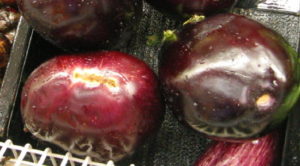
The female is on the left (slit) and the male (round) on the right
Note: To salt or not to salt prior to cooking? Sprinkling salt over eggplant slices before cooking them draws out the vegetable’s moisture. It’s a process known as “degorging”.
Larger, older eggplants have brown seeds that contain a bitter liquid. Salting eggplants removes some of this liquid and improves their flavor. In general, it’s not necessary to salt smaller eggplants since they have fewer seeds than larger eggplants.
I like the taste of eggplant and prefer to fry the eggplant lightly for that reason. I do not use breadcrumbs, I simply dip in season flour and then egg wash; eggs beaten with a little water and then fry.
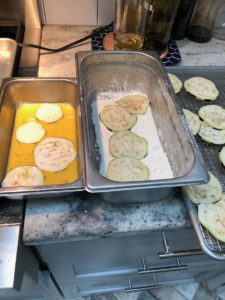
Seasoned flour for dipping and egg wash
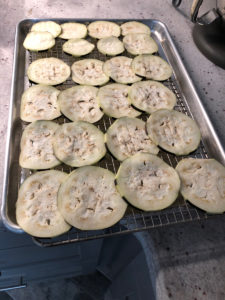
I salted the eggplant for this version because there were some brown seeds.
I like to fry my eggplant is a fryer, (375-degrees) it takes a bit longer, however, it uses less oil because the temperature is easier to control, however it you do not have an electric fryer it can be done in a pot with a frying thermometer or simply in a sauce pan.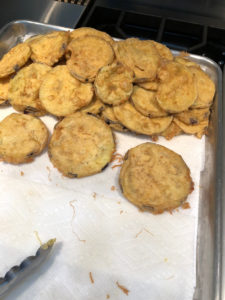
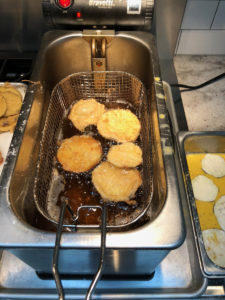
Assembly is easy, a bit of sauce in the bottom of a pan, a later of eggplant slightly overlapping, with a layer of mozzarella cheese and your favorite marinara sauce. I suggest that you do not use pre-shredded cheese. It’s a tempting shortcut: spend a few more dollars for a bag of shredded cheese and save time—and potentially skinned knuckles—by not having to grate the cheese yourself. I usually prefer to shred my own mozzarella for pizza, pasta bakes, etc., since most pre-shredded cheese contains anti-caking agents like cellulose powder (miniscule pieces of plant fiber) that can make the cheese stiff and dry.
Bake at 350-degrees for about 30 minutes, I like to make a day ahead and re-heat because I thing the flavor meld better.
